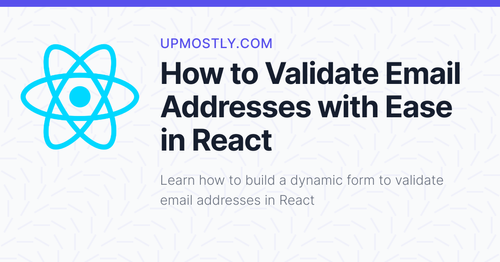In the realm of web development, creating a seamless and user-friendly experience is paramount. Email validation is a crucial aspect of this user experience, ensuring that the data users input into your application is accurate and reliable. In this comprehensive guide, we will explore the world of email validation in React, offering practical methods, expert tips, and answers to common questions to help you implement this vital feature effectively.
The Significance of Email Validation in React
Email validation serves several essential purposes in web applications developed with React:
Data Accuracy: Valid email addresses are crucial for accurate communication and user engagement.
User Experience: Ensuring that users provide valid email addresses during registration and other interactions enhances the overall user experience.
Security: Validating email addresses reduces the risk of unauthorized access and misuse of your application.
Compliance: In some cases, email validation is required to comply with industry standards and regulations.
Practical Methods for Email Validation in React
To harness the full potential of email validation in your React applications, consider the following methods and best practices:
Regular Expressions (Regex): Utilize Regex patterns to check if the entered email matches a valid email format. Several Regex patterns are available for this purpose.
Third-Party Libraries: Leverage third-party libraries such as Yup, Formik, or React Hook Form that provide built-in validation features, including email validation.
Custom Validation Functions: Create custom validation functions in JavaScript to verify email addresses according to your specific requirements.
Real-Time Validation: Implement real-time validation, providing instant feedback to users as they input their email addresses.
Server-Side Validation: Always combine client-side validation with server-side validation to ensure data accuracy and security.
Implementing Email Validation in React Components
Now, let's explore how to implement email validation in React components effectively:
State Management: Use React state or state management libraries like Redux or Mobx to handle the email input and validation status.
Validation Logic: Write validation logic that triggers when the user interacts with the email input field. Display feedback messages or visual cues accordingly.
Feedback to Users: Provide clear and concise feedback to users, indicating whether their entered email is valid or invalid.
Conditional Rendering: Conditionally render components or buttons based on the validation status to prevent users from progressing with invalid data.
Form Submission: Ensure that the form or registration process does not proceed until a valid email address is provided.
Common Questions About Email Validation in React
Let's address some frequently asked questions related to email validation in React to provide you with a comprehensive understanding of this crucial feature:
1. Is client-side email validation enough, or should I also perform server-side validation?
Both client-side and server-side validation are necessary. Client-side validation enhances user experience, while server-side validation ensures data accuracy and security.
2. Which third-party libraries are best for email validation in React applications?
Some popular libraries include Yup, Formik, and React Hook Form. The choice depends on your specific project requirements.
3. How can I create custom validation rules for email addresses in React?
You can create custom validation functions in JavaScript and integrate them into your React components.
4. What is the impact of poor email validation on user experience and data accuracy?
Poor email validation can lead to frustrating user experiences, inaccurate data, and potential security vulnerabilities.
Conclusion
Email validation in React is a fundamental aspect of creating a seamless and secure user experience in web applications. By understanding its significance, implementing practical methods, and following best practices, you can ensure that the email addresses collected from users are accurate and reliable.
Embrace email validation in React as a vital feature that not only enhances data accuracy and security but also contributes to a positive and trustworthy user experience, ultimately elevating the quality of your web applications.



